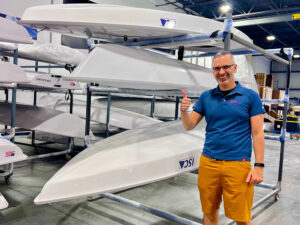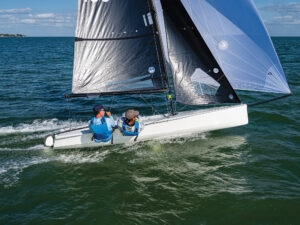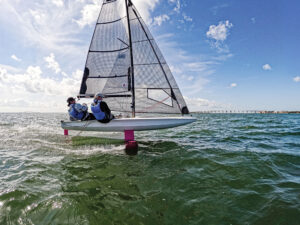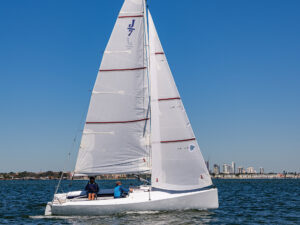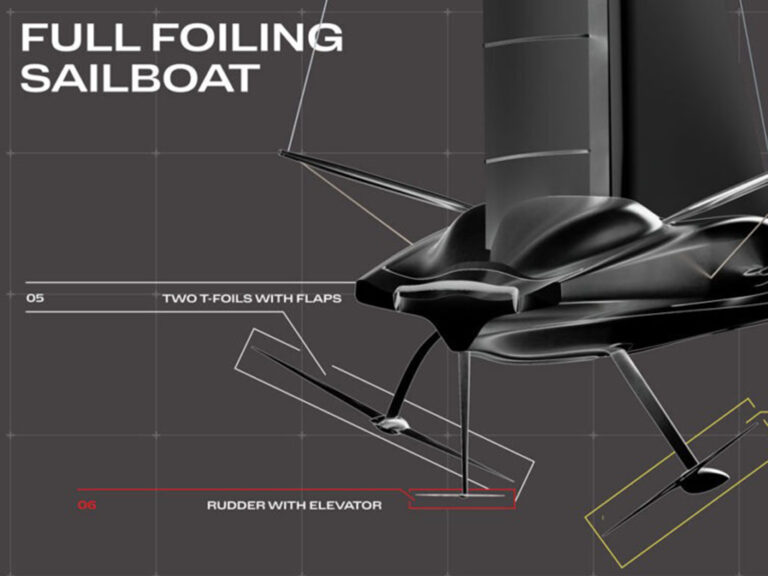
Moneypenny 368
Jim Swartz considers himself a novice to the sport of yacht racing, having only started racing three years ago with his Swan 601 Moneypenny, but he’s certainly jumped in with both feet. He’s now the proud owner of the Reichel/Pugh-designed STP 65 Moneypenny, which, as we went to print, had just finished sea trials in Australia. It will be a big change for Swartz to move up to the STP 65, which is considerably more powered up and lighter. “It’s only five feet longer,” says Swartz, “but it’s a much, much bigger boat, and has a much wider stern with a pretty aggressive chine.”
“There’s a lot of room within the STP box rule to develop the shape of the boat and the appendages,” says designer Jim Pugh. “It limits displacement and draft quite tightly and the maximum beam, but hull shape is completely open.” Pugh says they developed a large number of different shapes to look at. “There are no girth measurements on these boats, and because it’s a box rule you tend to push the stern fairly wide and maximize your heel waterline,” he says. “And at the same time you push the volume forward to keep the boat balanced for good power reaching. Moneypenny has a relatively straight bow with some displacement pushed forward underneath because these guys will be doing a lot of windward/leeward racing in moderate air. “
Other interesting features of the STP 65 class are the requirements for a lifting keel as well as a retractable propeller shaft and prop. Pugh says the former was a challenge, and that it’s mechanical rather than hydraulic, but refuses to go into any detail. He was more forthcoming about the prop and its shaft. “It’s obviously more complicated than an exposed shaft,” he says, “but it’s more efficient. You can have a good, three-bladed prop, as opposed to a little folding prop.”
“We’re different from the first STP 65, Rosebud, in that we have a different mainsheet system,” says Swartz. “We went to the split mainsheet layout that’s become popular in the TP52 class.” In addition, Swartz and his team didn’t want the class mandated single, fixed backstay. “We wanted the flexibility that running backstays would give us, so we worked hard with Rosebud to allow running backstays. The main advantage of the runners is to take advantage of different sail shapes.”
Pugh expects Moneypenny’s speed potential to be in the realm of 11 knots upwind, and much higher downwind. “I think the boat will be spectacular,” he says. “It only weighs 13 tons, and if you’re on the wind and crack off three or four degrees, or even twenty degrees, the increase in speed will be amazing.”
Swartz, of course, is optimistic. “I don’t know how fast we’ll be sailing,” he says. “I just hope it’s going to be real fast.”
-Tony Bessinger
Technical Highlights
LOA 65’7”
Beam 15’9″
DSPL 28,660 lbs.
Draft 15’9”
SA (u/d) 2,766 sq. ft./6,039 sq. ft.
Sails North Sails
Mast Southern Spars
Hardware Harken
Electronics B&G
Builder McConaghy Boats Australia

